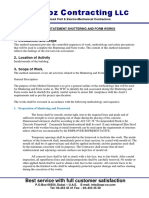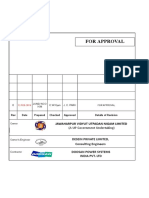AAC Block Works Method Statement1
AAC Block Works Method Statement1
Uploaded by
Hazem Shaker Abu ShaabanCopyright:
Available Formats
AAC Block Works Method Statement1
AAC Block Works Method Statement1
Uploaded by
Hazem Shaker Abu ShaabanCopyright
Available Formats
Share this document
Did you find this document useful?
Is this content inappropriate?
Copyright:
Available Formats
AAC Block Works Method Statement1
AAC Block Works Method Statement1
Uploaded by
Hazem Shaker Abu ShaabanCopyright:
Available Formats
Aker Construction Trade& Industrial INC.
Method statement for Block works
1-Objective: This method statement to define the requirements for execution of Autoclaved Aerated Concrete (AAC) block works. 2-Scope: For internal and external block walls of the Hospital under the scope of the contract. 3- References: 1- Project approved drawings. 2- TS 2510 and (Turkish) Disaster code. 4 Procedure: 4.1 Submittals 4.1.1 Aker will submit AAC blocks supplier and sample for the consultant's approval. 4.1.2 Aker will submit AAC blocks Adhesive for the consultant's approval. 4.2 Preparations 4.2.1 The area/floor proposed to start the block work activity in, should be cleaned from any debris, old mortar, dust 4.2.2 The surveyor will set out all the required axes, offset lines and points. 4.2.3 The block work area will be wetted with water. 4.2.4 Surface of AAC blocks to be joined with mortar is to be wetted. 4.2.5 The mortar for AAC block will be blocks adhesive. 4.2.6 The base bed courses must invariably be laid in ordinary mason's mortar, the Composition of bedding mortar 1:1:6 (1 cement: 1 lime: 6 sand). 4.2.7 The joint adhesive thickness should be approximately 2-3 mm, and the thickness of joint for base course bed should be at least 12.5 mm.
Aker Construction Trade& Industrial INC.
4.3 Connections 4.3.1 Wall to Wall connections: In case of L connection interlocking bond will be used, and the galvanized steel ties will be used every three courses in case of T connection. 4.3.2 Wall to column Connection: Mason's mortar should be used at all wall to column Interface joints, columns should be brushed dust-free, and if necessary roughened by basting to ensure good bond. Walls should be mechanically tied to columns with 30 cm steel anchor rods 2T10 mm every two courses. 4.3.3 In case of Wall to beam Connections and wall to floor soffit connections: ordinary mason's mortar should be used. 4.4 Block laying: 4.4.1 The first course of the block will be laid in a full bed of ordinary mortar. This will be inspected for internal dimensions, door sizes, distances 4.4.2 The block mason will complete the wall on the approved first course. 4.4.3 The maximum height to be built in one day is 1.6 m (8 courses). 4.4.4 For the walls not have opening for doors and windows the heights more than 3 m a concrete tie beam 200 mm depth will be poured for stiffness purposes. 4.4.5 For the walls have opening for doors and/or windows the overhead lintels should be continue along the wall and in this case no need for concrete tie beams. 4.4.6 In-situ reinforced concrete lintels and beams should be 4T10 and T8/30 cm stirrups. 4.4.7 Cast-in-situ reinforced concrete window sills with 200 mm depth, 4T10 and T8/30 cm stirrups. 4.4.8 Keep AAC unit work free of mortar droppings as work progresses and, at completion of work, rub AAC unit to remove excess mortar. 4.4.9 The block walls will be finally inspected by Engineer for verticality, alignment ..
Aker Construction Trade& Industrial INC.
4.4.9 Tolerances: 1. Maximum variation from plumb: 0.6mm in 3 m, not exceeding 0.9mm in 6m. 2. Maximum variation from level: 0.6 mm in 6m, not exceeding 12.5mm in 15 m or more.
5 Inspection for block works 5.1 Cleaning of concrete surface. 5.2 Setting out the first course. 5.3 Inspection of the block wall.
You might also like
- 007 - Internal Waterproofing ChecklistDocument2 pages007 - Internal Waterproofing ChecklistCarl Xhing85% (27)
- The Working Drawing - The Architects Tool by Annette Spiro and David GanzoniDocument328 pagesThe Working Drawing - The Architects Tool by Annette Spiro and David GanzoniNguyễn Anh Khoa100% (4)
- Method Statement - Anticlimb FencingDocument1 pageMethod Statement - Anticlimb FencingfatinNo ratings yet
- Work Method Statement For PlasteringDocument9 pagesWork Method Statement For PlasteringMhando IgnasNo ratings yet
- Method Statement For PlasteringDocument6 pagesMethod Statement For PlasteringSana NazirNo ratings yet
- Door InstallationDocument2 pagesDoor Installationyusz7856% (9)
- Method Statement For Brick WallDocument16 pagesMethod Statement For Brick WallMin Luo100% (7)
- Method Statement Aac BlocksDocument5 pagesMethod Statement Aac BlocksRizzat ZainalNo ratings yet
- Method Statement For Door FrameDocument12 pagesMethod Statement For Door FrameMin Luo100% (5)
- Method Statement For Painting WorksDocument5 pagesMethod Statement For Painting WorksJoe_Average78% (9)
- Method Statement For Door and Window Installation PDFDocument13 pagesMethod Statement For Door and Window Installation PDFpp100% (4)
- Method Statement For Waterproofing of ToiletsDocument1 pageMethod Statement For Waterproofing of ToiletsUpali Karunarathne100% (3)
- Method Statement For Concrete Topping (Ramp Slab)Document2 pagesMethod Statement For Concrete Topping (Ramp Slab)mikollim100% (4)
- Tiles Method StatementDocument5 pagesTiles Method StatementMhando IgnasNo ratings yet
- Method Statement For PlasteringDocument14 pagesMethod Statement For Plasteringjameel100% (3)
- Work Method Statemnet For Waterproofing WorkDocument2 pagesWork Method Statemnet For Waterproofing WorkPunk Gowthaman100% (1)
- Method Statement For Stamped ConcreteDocument4 pagesMethod Statement For Stamped ConcreteAndré van Schalkwyk100% (2)
- Method Statement For: Tiling WorkDocument5 pagesMethod Statement For: Tiling WorkHussam Waleed100% (4)
- Methodology For Honeycomb RepairDocument2 pagesMethodology For Honeycomb Repairanbunilavan50% (4)
- Method StatementDocument5 pagesMethod StatementMalith De Silva100% (2)
- Method Statement For Columns2Document5 pagesMethod Statement For Columns2Jasmine Tso100% (2)
- Method Statements For Plain Cement ConcreteDocument5 pagesMethod Statements For Plain Cement ConcreteKrm Chari71% (7)
- Screed-Method StatementDocument5 pagesScreed-Method StatementTATATAHER100% (4)
- Method Statement For Anti Termite TreatmentDocument5 pagesMethod Statement For Anti Termite Treatmentray50% (2)
- Method Statement For Tiles InstallationDocument4 pagesMethod Statement For Tiles InstallationVeronica De Jesus100% (1)
- Plinth Beam Work ProcedureDocument3 pagesPlinth Beam Work ProcedureMohd Muksin75% (4)
- Work Method Statement - POP PUNNINGDocument3 pagesWork Method Statement - POP PUNNINGSathish Gowda100% (1)
- Work Method Statement - TEXTURE PAINTDocument3 pagesWork Method Statement - TEXTURE PAINTSathish Gowda0% (2)
- Method Statement For Cuplock Shuttering WorkDocument7 pagesMethod Statement For Cuplock Shuttering WorkAkash Yadav100% (3)
- Method Statement For Water Stopper-BSMMUDocument5 pagesMethod Statement For Water Stopper-BSMMUEngr. Masud Rahman100% (1)
- Waterproofing Checklist-1Document3 pagesWaterproofing Checklist-1mukesh patel88% (8)
- Method Statement For BlockworkDocument3 pagesMethod Statement For BlockworkPunk Gowthaman100% (3)
- 5.method Statement Shuttering and Form WorkDocument4 pages5.method Statement Shuttering and Form Workشاز إياس100% (1)
- Gypsum Plaster ChecklistDocument3 pagesGypsum Plaster ChecklistFaruq Khan80% (5)
- Method Statement For Ceramic Tiles-Wall & Floor) (K)Document11 pagesMethod Statement For Ceramic Tiles-Wall & Floor) (K)Akash YadavNo ratings yet
- Method Statement of Plaster Ceiling Installation: ContentDocument3 pagesMethod Statement of Plaster Ceiling Installation: ContentChezy629100% (6)
- Method Statement of Construction Joint RepairingDocument1 pageMethod Statement of Construction Joint RepairingSupun Sandaruwan100% (2)
- Method of Statement For Aac Block WorkDocument10 pagesMethod of Statement For Aac Block Workjohn paul100% (1)
- 9.Ms-METHOD STATEMENT FOR TILING, SKIRTING, TOILET DADO & KITCHEN PLATFORM WORKDocument15 pages9.Ms-METHOD STATEMENT FOR TILING, SKIRTING, TOILET DADO & KITCHEN PLATFORM WORKShenbagaraja Pandian100% (2)
- Anite WorkDocument4 pagesAnite WorkShenbagaraja PandianNo ratings yet
- Method of AAC BlockworkDocument11 pagesMethod of AAC BlockworkShamim Ahsan ZuberyNo ratings yet
- Checklist For Plaster PreparationDocument1 pageChecklist For Plaster PreparationMani AppaNo ratings yet
- Method Statement For HoneycombDocument2 pagesMethod Statement For HoneycombCHAR JIN CHEE50% (2)
- Block Work Masonry MethodologyDocument4 pagesBlock Work Masonry MethodologyEyutt Hghgh100% (1)
- Work Method Statement For Plastering WorkDocument4 pagesWork Method Statement For Plastering WorkAmit Khazanchi100% (1)
- Sunken FillingDocument3 pagesSunken FillingASHOKKUMAR100% (1)
- Method Statement FALSE CEILING-1Document7 pagesMethod Statement FALSE CEILING-1beshnu garanaik100% (2)
- Method Statement For Concrete RepairingDocument13 pagesMethod Statement For Concrete RepairingMihirdutta100% (6)
- Checklist For Wall Panels InstallationDocument2 pagesChecklist For Wall Panels InstallationChristos LoutrakisNo ratings yet
- Method Statement For Tiling WorkDocument4 pagesMethod Statement For Tiling WorkMaca100% (1)
- Method Statement For Exterrnal PlasteringDocument7 pagesMethod Statement For Exterrnal PlasteringSagar ParabNo ratings yet
- Method Statement of Waterproofing (Wet Area & Brick Bat Coba)Document4 pagesMethod Statement of Waterproofing (Wet Area & Brick Bat Coba)Salman Shah100% (1)
- Method Statement For Wall PuttyDocument5 pagesMethod Statement For Wall PuttySagar Parab100% (1)
- Anti Termite Treatment ChecklistDocument2 pagesAnti Termite Treatment Checklistpraveendoka100% (3)
- Construction Method of StatementDocument11 pagesConstruction Method of Statementperunding thd100% (3)
- 7.Ms-External Plaster WorkDocument6 pages7.Ms-External Plaster WorkShenbagaraja PandianNo ratings yet
- Checklist For Waterproofing - ToiletsDocument1 pageChecklist For Waterproofing - Toiletsyash shah0% (1)
- Checklist For Wall Tiling or Dado WorkDocument1 pageChecklist For Wall Tiling or Dado WorkDinesh Kumar PatelNo ratings yet
- AAC Block Works Method Statement1Document3 pagesAAC Block Works Method Statement1Amit PratapNo ratings yet
- AAC-Block-Works-Method-Statement (Nat Research)Document3 pagesAAC-Block-Works-Method-Statement (Nat Research)Anatolie Amper100% (1)
- Orks Block W AAC Tatement For Method S: 1-ObjectiveDocument3 pagesOrks Block W AAC Tatement For Method S: 1-ObjectiveCatherine CatacutanNo ratings yet
- Low Cost TechniquesDocument24 pagesLow Cost TechniquesAkanksha Rajput100% (1)
- Interior and Exterior MaterialsDocument51 pagesInterior and Exterior MaterialsMyla LayanNo ratings yet
- ETERNO Catalog 2020Document15 pagesETERNO Catalog 2020Karam ZahranNo ratings yet
- ReviewDocument40 pagesReviewRossana VerdidaNo ratings yet
- Estimating & Costing-1 PDFDocument229 pagesEstimating & Costing-1 PDFGokul Kannan100% (2)
- Building Works: (2017 - 2018) Lead Chart and Lead ChargesDocument25 pagesBuilding Works: (2017 - 2018) Lead Chart and Lead Chargesjunaid farooquiNo ratings yet
- Long Wall & Short Wall Method PDFDocument5 pagesLong Wall & Short Wall Method PDFAnithaNo ratings yet
- Calicut UniversityDocument23 pagesCalicut UniversityAr Shahanaz JaleelNo ratings yet
- Terzaghi's Bearing Capacity EquationsDocument23 pagesTerzaghi's Bearing Capacity Equationskiddho100% (2)
- Seismic Rules Masonry Walls Eurocode 6Document8 pagesSeismic Rules Masonry Walls Eurocode 6Nikolai BogdanovNo ratings yet
- Answers To Selected Problems: Sieve No. Percent FinerDocument10 pagesAnswers To Selected Problems: Sieve No. Percent FinerLucas Cavalcante de AlmeidaNo ratings yet
- Estimation and Professional Practices-Ca2Document3 pagesEstimation and Professional Practices-Ca2Rajen KoleyNo ratings yet
- TLE - IA Masonry Grades 7-10 4.6.2014Document20 pagesTLE - IA Masonry Grades 7-10 4.6.2014Yingying MimayNo ratings yet
- Work Sheet For Design of Concrete Mix: Item No.: 400 (23) - Bored PileDocument16 pagesWork Sheet For Design of Concrete Mix: Item No.: 400 (23) - Bored PileMae Ann GonzalesNo ratings yet
- Hollow Bricks Manufacturing StepsDocument3 pagesHollow Bricks Manufacturing StepsClark G. BennettNo ratings yet
- Reinforced-Concrete - Material SUPPLIERS PDFDocument21 pagesReinforced-Concrete - Material SUPPLIERS PDFJohnvirgo CorpuzNo ratings yet
- Dos Iii - Unit Iv Masonry WallDocument26 pagesDos Iii - Unit Iv Masonry WallMohamed ArzathNo ratings yet
- Ceo - Abc Architectural SolutionsDocument21 pagesCeo - Abc Architectural SolutionsCRISTHIAN ANCHUNDIA BNo ratings yet
- HILTI - Smjernice Za Proračun Ojačanja Zidanih Zidova Armiranim Mortom - ProračunDocument23 pagesHILTI - Smjernice Za Proračun Ojačanja Zidanih Zidova Armiranim Mortom - Proračunk08ivanNo ratings yet
- FBM Kicukiro District Exam 2023-2024Document3 pagesFBM Kicukiro District Exam 2023-2024cyusemmy03No ratings yet
- Tle 150 BulletsDocument8 pagesTle 150 BulletsJan ArtNo ratings yet
- QDCMP 4.4 Buildings in A Transport Noise CorridorDocument19 pagesQDCMP 4.4 Buildings in A Transport Noise Corridorgoodspeed_phNo ratings yet
- SL No Description No L B D CF Quantity RemarkDocument11 pagesSL No Description No L B D CF Quantity RemarkhasiljiNo ratings yet
- Cracks in BuildingsDocument35 pagesCracks in BuildingsAbdul Azeem100% (1)
- C1 C1 C1 C1: Schedule of ColumnsDocument1 pageC1 C1 C1 C1: Schedule of ColumnsSyed Iftikhar QasimNo ratings yet
- Floating Drum DigestersDocument6 pagesFloating Drum DigesterstinoNo ratings yet
- Schedule of RatesDocument163 pagesSchedule of RatesdarenplanNo ratings yet
- Gortan Castle BuildingDocument3 pagesGortan Castle BuildingAr RAJESH THAKURNo ratings yet
- Mines in RajastahnDocument5 pagesMines in Rajastahnsourabh18121987No ratings yet

























































































